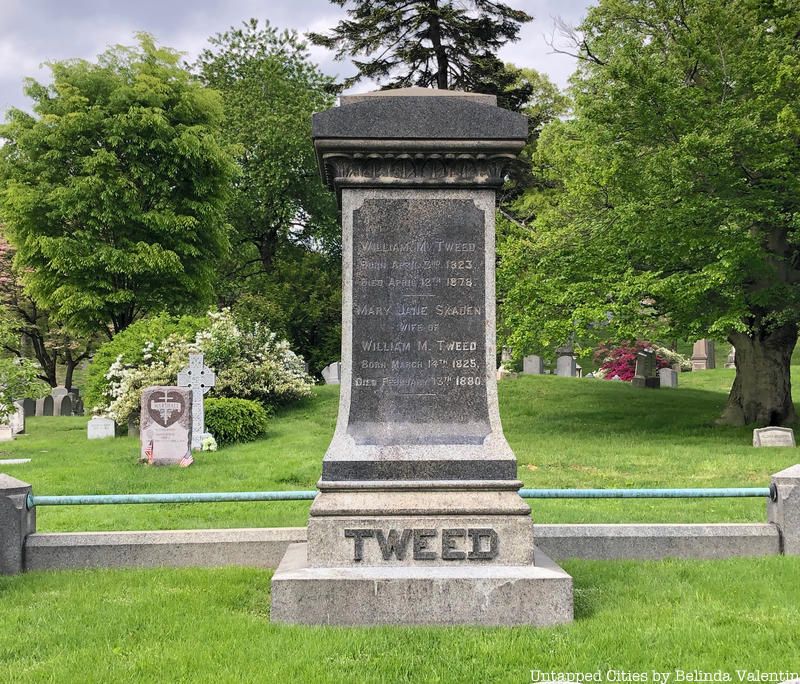Last-Minute NYC Holiday Gift Guide 🎁
We’ve created a holiday gift guide with presents for the intrepid New Yorker that should arrive just in time—


Green-Wood Cemetery was founded in 1838 as one of America’s first rural cemeteries. Almost two centuries later, Green-Wood remains a cultural institution and an outdoor museum that documents the history and evokes the cultures of New York and the nation. Green-Wood’s 478 acres serve as the final resting place for over 570,000 permanent residents, and many visit the Cemetery daily to take in this rich history. Jean-Michel Basquiat, Boss Tweed, Leonard Bernstein and Horace Greeley are among those interred on the grounds. But back when the Cemetery first opened, it was one of the most prominent tourist destinations for families.

At first, 14-by-27-foot lots were sold for $100 each, and by the early 1860s, the cemetery had 7,000 annual burials and 100,000 graves. A ferry service to the Cemetery was established in 1846, to accommodate visitors. Just a decade or two after opening, Green-Wood housed the graves of many famous and wealthy New Yorkers, which drew in crowds. Green-Wood became more popular after former governor DeWitt Clinton was disinterred from a cemetery in Albany and moved to Green-Wood, where a monument to him was erected in 1853.

While there is no record of exactly how many visitors Green-Wood Cemetery had in the 19th century, it has been said that it rivaled only Niagara Falls as a tourist attraction in the U.S. Early literature of the Cemetery mentions “The Tour,” a route designed by the Cemetery that visitors could follow to catch all the points of interest at the Cemetery. Naturally, the most desired property for potential lot owners was along that route. The Cemetery also offered unobstructed views to Manhattan and New York Harbor, including a view of the Statue of Liberty, once it was constructed.
“The viable associations of the Green-Wood Cemetery are intended to be exactly what its name implies — verdure, shade, ruralness, natural beauty; every thing, in short, in contrast with the glare, set form, fixed rule, and fashion of the city,” wrote David Bates Douglass, Green-Wood designer in Exposition of the Plan and Objects of the Green-Wood Cemetery.

The Cemetery also provided a carriage service during the 19th century, available for the accommodation of “lot owners and visitors” that ran as frequently as every 15 minutes from May through October. This advance was particularly significant for families of those killed in the Civil War, since starting in 1862, free interments were offered to the families of New York soldiers who died in conflict. This was accompanied by a booklet describing all the notable memorials along the route. There were also souvenir booklets produced with images of the Cemetery, bound pocket visitor’s maps, and stereoview images that pointed to its popularity as a tourist attraction. Today, a trolley service is part of various tours offered by the Cemetery.

“The whole character of the landscape accords perfectly with the spirit of the place. Here are rural beauty and repose. No human dwelling is within view, if we except the still mansions of the dead. Neither sight nor sound is here to remind us of the noisy, living world,” wrote Nehemiah Cleaveland, Green-Wood historian in Green-Wood Illustrated.

And tourism further grew as public streetcar and elevated lines were established across Brooklyn, around the same time that construction was underway at Prospect Park. Green-Wood built the Fort Hamilton gate in 1876 to accommodate anticipated crowds, and soon after flower shops and monument sellers sprouted up by the gate. This gate was re-opened for public access in 2020 to accommodate an increase in visitors during the coronavirus pandemic. A Victorian greenhouse across from the main entrance, the McGovern-Weir Greenhouse, still exists and has been under restoration for several years.

One of the Cemetery’s oldest features, the Catacombs, remains hidden away to the public, except for rare tours. The Catacombs consist of 30 vaults set beneath a hill and secured by locked iron gates. Dating back to the early 1850s, the Catacombs provided an alternative to burials in the ground when families couldn’t afford a mausoleum for a loved one. One of the most famous people entombed in the Catacombs is Ward McAllister, a Gilded Age high society tastemaker. It was McAllister who first referred to the guests of Mrs. Astor’s ballroom as “The 400,” an exclusive group of New York City’s highest-ranking members of society. The catacombs were not intentionally constructed for the cemetery but were there previously due to active mining for gravel.

On October 1st, explore the historic Green-Wood Cemetery after dark and enter the catacombs, an area usually off-limits to the public! On this Untapped New York Insider tour led by a Green-Wood Cemetery tour guide, discover the connection between the tobacco shop owner John Anderson, the mysterious murder of Mary Rogers, “The Beautiful Cigar Girl,” and Edgar Allen Poe. Visit the Pilot’s Monument, dedicated by New York Harbor pilots after the tragic sinking of the John Minturn. Meet Elias Howe, the man behind the sewing machine and his beloved dog Fannie, buried behind Howe’s monument. Stop by the grave of Elizabeth Gloucester, the Black woman entrepreneur whose fortune helped fund John Brown’s raid on Harpers Ferry. And take a sneak peek into one of the Cemetery’s rarely opened structures! The event is free for Untapped New York Insiders (and get your first month free with code JOINUS).
Next, check out the Top 10 Secrets of Brooklyn’s Green-Wood Cemetery!
Subscribe to our newsletter